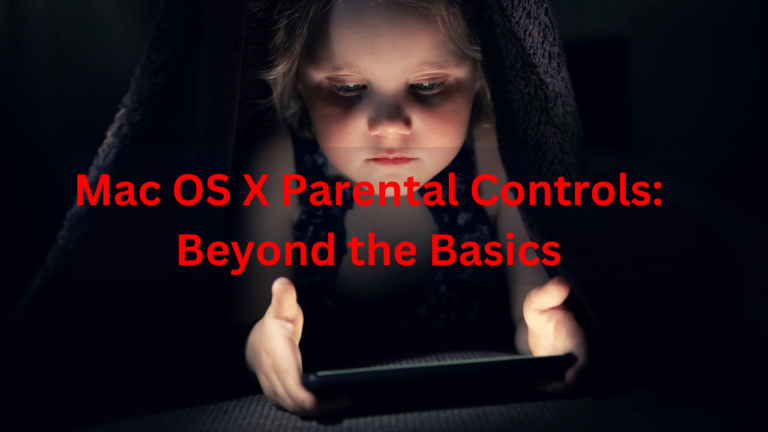Introduction
Mac OS X Parental Controls offers a broad set of tools designed to help parents manage and monitor their child’s activities on Mac computers. With these controls, you can create a safer online environment for your family by implementing restrictions and setting boundaries tailored to your child’s age and maturity level.
Setting Time Limits and Bedtime
Mac OS X Parental Controls provide parents with the ability to establish time limits for their child’s computer usage and implement a bedtime schedule to ensure healthy screen time habits.
Time Limits: With the Time Limits feature, parents can define specific time periods during which their child is allowed to use the computer. This functionality helps encourage a balanced approach to screen time, preventing excessive use that may interfere with other activities such as homework, chores, or outdoor play. By setting boundaries around when the computer can be accessed, parents can promote healthier habits and establish a routine that supports their child’s overall well-being.
Parents have the flexibility to customize time limits based on their family’s schedule and individual preferences. For example, they can designate certain hours during the weekdays for academic-related tasks and leisure time, while weekends may have more relaxed restrictions. Additionally, parents can allocate different time limits for weekdays and weekends to accommodate varying routines and activities.
Bedtime: The Bedtime feature builds upon the concept of time limits by automatically disabling access to the computer during designated hours, typically during the night when it’s time for sleep. This functionality helps ensure that children get enough restorative sleep each night by preventing late-night screen time that can disrupt their sleep patterns and overall health.
Parents can set a bedtime schedule tailored to their child’s sleep habits and family routines. They can specify the start and end times for the bedtime period, with the computer automatically becoming inaccessible outside of these hours. This hands-off approach eliminates the need for parents to manually enforce bedtime rules, allowing for a more consistent and stress-free bedtime routine for the entire family.
Overall, the Setting Time Limits and Bedtime features of Mac OS X Parental Controls empower parents to establish healthy screen time boundaries for their children. By promoting balanced computer usage and ensuring adequate rest, parents can support their child’s physical, mental, and emotional well-being in today’s digital world. These tools provide a valuable framework for fostering responsible technology use and maintaining a harmonious family environment.
Restricting Access to Apps and Websites
Mac OS X Parental Controls offer robust functionality for parents to regulate their child’s access to specific applications and websites, ensuring a safer and more controlled online experience.
Whitelists and Blacklists: One of the primary methods for restricting access is through the use of whitelists and blacklists. Whitelists contain approved applications and websites that your child is permitted to access, while blacklists contain restricted or blocked ones. This allows parents to curate a tailored list of allowed content, ensuring that their child only interacts with age-appropriate and safe material.
Customizable Filters: Mac OS X Parental Controls also provide customizable filters that allow parents to block or allow access based on various criteria, such as content type or category. For example, parents can choose to block access to social media platforms, online gaming sites, or adult content websites. This level of customization enables parents to create a tailored internet experience that aligns with their family’s values and preferences.
Time-Specific Restrictions: In addition to permanent restrictions, parents can implement time-specific limitations on app and website access. For instance, they can configure settings to allow access to certain educational apps and websites only during designated study hours, while blocking them during leisure time or bedtime. This helps parents strike a balance between productive use and recreational use of digital resources.
Parental Approval: Some parental control features allow for parental approval of app installations and website visits. When a child attempts to download a new app or access a new website, parents receive a notification or request for approval. This gives parents the opportunity to review the content and decide whether it is appropriate for their child before granting access.

Comprehensive Reporting: Mac OS X Parental Controls provide comprehensive reporting features that allow parents to monitor their child’s app and website usage over time. They can view detailed reports that show which applications and websites their child has accessed, how frequently they have been used, and for how long. This insight enables parents to identify any potential concerns or patterns of excessive usage and take appropriate action.
Overall, the ability to restrict access to apps and websites through Mac OS X Parental Controls empowers parents to create a safer and more controlled online environment for their children. By leveraging customizable filters, time-specific restrictions, and comprehensive reporting, parents can ensure that their child’s digital experiences align with their family values and promote responsible technology use.
Managing Communication and Social Media
Mac OS X Parental Controls provide parents with tools to monitor and manage their child’s communication and social media usage, helping to protect them from inappropriate content and online predators while promoting responsible digital citizenship.
Messaging and Chat Controls: One of the key features of parental controls is the ability to monitor and regulate messaging and chat applications. Parents can set restrictions on which messaging apps their child can use and with whom they can communicate. This helps prevent exposure to strangers and inappropriate content while fostering a safer online environment for social interaction.
Content Filtering: Mac OS X Parental Controls also offer content filtering capabilities for social media platforms. Parents can set parameters to block or filter out certain types of content, such as explicit language, violence, or mature themes. This helps ensure that their child’s social media feeds are age-appropriate and free from harmful content.
Privacy Settings: Parents can help protect their child’s privacy and online safety by configuring privacy settings for social media accounts. This includes setting restrictions on who can view their child’s profile, who can contact them, and what information is publicly visible. By carefully managing privacy settings, parents can minimize the risk of their child being targeted by online predators or experiencing cyberbullying.
Monitoring Activity: Mac OS X Parental Controls allow parents to monitor their child’s activity on social media platforms, providing insight into who they are interacting with and what content they are engaging with. This monitoring can help parents identify any concerning behavior or interactions and take appropriate action to address it.
Time Management: In addition to monitoring communication and social media usage, parental controls also offer tools for managing screen time. Parents can set limits on the amount of time their child spends on social media each day, helping to prevent excessive use and encourage a healthy balance between online and offline activities.
Educational Resources: Mac OS X Parental Controls may also provide educational resources and guidance for parents on how to promote safe and responsible social media use. This may include tips for talking to children about online safety, guidance on setting boundaries and rules, and resources for addressing cyberbullying or other online risks.
By leveraging the communication and social media management features of Mac OS X Parental Controls, parents can help protect their child from online threats while empowering them to navigate the digital world responsibly. These tools provide a valuable framework for promoting safe and positive online interactions and fostering healthy digital habits from a young age.
Monitoring Activity and Usage Reports
Mac OS X Parental Controls offer robust features for parents to monitor their child’s activity on the computer and generate comprehensive usage reports. These tools provide valuable insights into your child’s digital behavior, allowing you to stay informed and address any concerns proactively.
Activity Monitoring: Parental controls allow you to monitor your child’s activity on the computer in real-time, giving you visibility into which applications they are using and what websites they are visiting. You can track how much time they spend on the computer, which files they access, and even see a log of their keystrokes. This monitoring helps you understand your child’s digital habits and identify any potential issues or risks.
Website Visits: Parents can view a detailed log of their child’s website visits, including the URLs visited, the date and time of each visit, and the duration of time spent on each site. This allows you to see which websites your child is accessing and determine whether they are visiting age-appropriate or potentially harmful sites. You can also block access to specific websites if necessary.
Application Usage: Mac OS X Parental Controls provide insights into your child’s application usage, showing you which programs they are using and how frequently. This helps you understand which activities and interests are occupying their time on the computer and identify any excessive or inappropriate app usage.
Search History: Parents can access a log of their child’s search history, showing the terms they have searched for on the internet. This allows you to see what topics or interests are capturing their attention online and identify any potentially concerning search queries.
Usage Reports: In addition to real-time monitoring, parental controls allow you to generate usage reports that provide a summary of your child’s computer activity over a specified period of time. These reports may include metrics such as total screen time, most frequently used applications, top websites visited, and more. This comprehensive overview helps you track trends, identify patterns, and make informed decisions about your child’s digital habits.
Customizable Alerts: Some parental control features allow you to set up customizable alerts that notify you when certain activities occur. For example, you can receive an alert when your child attempts to access a blocked website or download a restricted application. This proactive notification system helps you stay on top of your child’s online behavior and address any issues promptly.
Overall, monitoring activity and generating usage reports with Mac OS X Parental Controls empower parents to take an active role in their child’s digital lives. By staying informed and involved, parents can promote responsible technology use, protect their child from online risks, and foster a healthy balance between screen time and offline activities.
Customizing Settings and Preferences
Mac OS X Parental Controls offer a range of customizable settings and preferences, allowing parents to tailor the level of protection and monitoring to their child’s individual needs and their family’s values. These customizable features empower parents to create a personalized and effective approach to managing their child’s digital activities.
Age-Appropriate Restrictions: One of the key aspects of customization is the ability to set age-appropriate restrictions based on your child’s maturity level and developmental stage. Mac OS X Parental Controls allow you to adjust settings such as content filters, time limits, and app restrictions to align with your child’s age and the specific concerns you may have about their online safety.
Content Filters: Parental controls provide customizable content filters that allow you to block or allow access to specific types of content, such as adult websites, violence, or gambling. You can fine-tune these filters to match your family’s values and preferences, ensuring that your child’s online experience is safe and age-appropriate.

Time Management: Another customizable feature is time management, which allows you to set limits on your child’s screen time and establish designated periods when the computer can be used. You can customize these time limits based on your family’s schedule, setting different restrictions for weekdays, weekends, and holidays to accommodate varying routines and activities.
App and Website Restrictions: Mac OS X Parental Controls give you control over which apps and websites your child can access, allowing you to create whitelists and blacklists of approved and restricted content. You can customize these restrictions based on your child’s interests, hobbies, and educational needs, ensuring that they have access to appropriate resources while protecting them from harmful or inappropriate content.
Privacy Settings: Parents can also customize privacy settings to protect their child’s personal information and online privacy. This includes setting restrictions on who can contact your child, who can view their profile and posts on social media, and what information is publicly visible. By customizing these settings, you can help prevent your child from being targeted by online predators or experiencing cyberbullying.
Notification Preferences: Some parental control features allow you to customize notification preferences, allowing you to receive alerts and updates about your child’s online activities. You can choose to receive notifications via email, text message, or in-app notifications and customize the types of events that trigger alerts, such as attempts to access blocked content or exceed time limits.
Overall, the ability to customize settings and preferences with Mac OS X Parental Controls gives parents the flexibility and control they need to create a safe and positive online environment for their child. By tailoring the settings to match your family’s needs and values, you can ensure that your child’s digital experiences are both enriching and secure.
Enabling Mac OS X Parental Controls
Enabling parental controls on a Mac computer is a straightforward process. Here’s a step-by-step guide to help you get started:
- Open System Preferences: Click on the Apple menu in the top-left corner of your screen and select “System Preferences” from the drop-down menu.
- Select “Parental Controls”: In the System Preferences window, locate and click on the “Parental Controls” icon. It typically features an image of a parent and child.
- Choose the User Account: If you have multiple user accounts set up on your Mac, select the account for which you want to enable parental controls from the list on the left side of the Parental Controls window.
- Click the Lock Icon: To make changes, you’ll need to click the lock icon in the bottom-left corner of the Parental Controls window and enter your administrator password when prompted.
- Enable Parental Controls: Once you’ve unlocked the settings, you can start enabling parental controls for the selected user account. You’ll find various options to control and monitor different aspects of the user’s activity, such as:
- Apps: Control access to specific applications or set age-appropriate ratings.
- Web: Restrict access to websites or allow access only to approved sites.
- Time Limits: Set limits on computer usage and establish bedtime restrictions.
- Privacy: Manage settings related to email, messaging, and sharing.
- Other: Additional settings may include controlling access to the App Store, preventing changes to system preferences, and more.
- Customize Settings: Depending on your preferences and your child’s needs, customize the settings to suit your requirements. You can adjust restrictions, time limits, and other preferences as needed.
- Review and Save Changes: Once you’ve configured the parental controls to your satisfaction, review your settings to ensure they meet your expectations. Click the lock icon again to save your changes.
- Exit System Preferences: Close the System Preferences window to exit the settings. Your parental controls are now enabled for the selected user account.
By following these steps, you can easily enable parental controls on your Mac and begin managing and monitoring your child’s computer usage to ensure a safer and more controlled online experience.
Limitations of Mac OS X parental controls
While Mac OS X parental controls offer valuable tools for managing and monitoring your child’s computer usage, it’s important to be aware of their limitations. Here are some common limitations to consider:
Limited Control Over Third-Party Apps and Websites: Parental controls may not have full control over third-party applications and websites. While you can block or allow access to certain apps and websites, it may not cover all online activities or content.
Inability to Monitor Activity on External Devices: Parental controls typically only monitor activity on the Mac computer itself. They may not track usage on external devices such as smartphones, tablets, or gaming consoles.
Technical Workarounds: Some tech-savvy children may find ways to bypass parental controls or circumvent restrictions, such as using a different user account or accessing the internet through alternative means.
Limited Customization Options: While parental controls offer customizable settings and preferences, they may not cater to every family’s specific needs and preferences. Certain features or restrictions may be too rigid or not flexible enough to accommodate individual requirements.
Dependency on User Compliance: Parental controls rely on user compliance to be effective. If a child disregards or disables the controls, they may not provide the intended level of protection.
Lack of Granular Control: While parental controls offer broad categories of restrictions and settings, they may lack granular control over specific content or activities. For example, you may not be able to block access to individual social media posts or specific YouTube videos.
Difficulty in Monitoring Encrypted Communications: Parental controls may face challenges in monitoring encrypted communications, such as end-to-end encrypted messaging apps. This can make it difficult to monitor certain types of online interactions.
Age-Dependent Effectiveness: The effectiveness of parental controls may vary depending on the age and technical proficiency of the child. Younger children may be more easily managed with parental controls, while older children or teenagers may find ways to work around them.
Despite these limitations, parental controls can still serve as valuable tools for promoting a safer and more controlled online environment for children. It’s important to use parental controls in conjunction with other strategies, such as open communication with your child, setting clear expectations, and teaching responsible digital citizenship.
Conclusion
In conclusion, Mac OS X Parental Controls offer a powerful suite of tools to help parents protect their children in the digital age. By setting time limits, restricting access to inappropriate content, and monitoring activity, you can create a safer online environment for your family and instill healthy screen-time habits. Take advantage of these features to empower your child to explore the internet responsibly while giving yourself peace of mind as a parent.
Do you know how to fix Mac Overheating Issues?
Learn More



